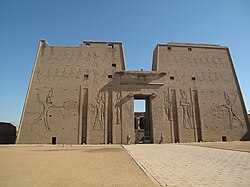History

In 1986, Professor Dr. Dieter Kurth of Hamburg University initiated a long-term project devoted to making a complete translation of the hieroglyphic inscriptions of the Temple of Edfu [2] [3] in Upper Egypt (Temple of Horus) that would meet the requirement of both linguistics and literary studies. The research comprised all internal parallels, relevant literature and an analysis of the systematics behind the decoration. Comprehensive analytical indices, useful for researchers of related disciplines, and a grammar of Graeco-Roman temple inscriptions were also compiled. The Edfu-Project, situated at the University of Hamburg, was financed until 2001 by the "German Research Foundation".
Since 2002, the Academy of Sciences of Göttingen has been in charge of the Edfu project, which is now financed by the "Academies' Programme". The research unit continues to work at Hamburg University. A translation of the inscriptions of the pylon (gate), including transcriptions and a commentary, was published in 1998 (Edfou VIII). This was followed in 2004 by a translation of the inscriptions of the outer girdle wall (Edfou VII) some of which had not previously been published. The most recent publication, released in 2014, provided a translation of the inscriptions of the inner side of the girdle wall (Edfou VI). Inscriptions of the open court and its columns (Chassinat, Edfou V-VI) are available in preliminary translation.